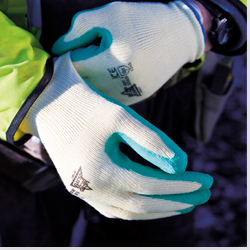Specialist gloves can offer protection against many harmful substances and hazards, as well as ensuring that employers are compliant with legal requirements.
Across many industries and operations, workers are required to use their hands and this involves a level of potential risk which should always be considered by employers prior to any task being undertaken.
There are many factors an employer should consider when purchasing PPE gloves, with the main ones being:
- - Which substances will be handled
- - What hazards are likely to be encountered
- - The type and duration of contact the gloves will need to withstand
- - Who will be wearing the gloves - including their size and any personal requirements
- - The job at hand, and any task-specific needs
Types of PPE gloves
There are a range of different types of PPE gloves for different purposes, and they all offer varying levels of specialised protection for your hands. Commonly seen types of PPE gloves include:
Typical applications for PPE gloves include medical, building, construction and trade-specific requirements.
The hazards that require safety hand protection
There are many hazards that require the use of specialist hand protection. These include:
- - Vibration from machinery
If you work in an industry which exposes workers to the above hazards, or other dangers, it’s vital to make sure they are properly protected with the right PPE gloves. It is important to note, however, that no glove material will protect against all substances, and gloves will often require replacement in line with manufacturer recommendations.
Employer Requirements
In industries where PPE is required to facilitate normal working, or where employees may be at risk to their health and safety, employers are responsible for:
- - Providing PPE equipment free of charge and ensuring it is fit for purpose
- - Providing training to ensure employees are aware of the need to wear PPE equipment appropriately
- - Maintenance, repairs or replacement of equipment when needed
- - Ensuring products carry the CE mark in accordance with the Personal Protection Equipment Regulations 2002
Regulations and Standards for Hand Protection
When it comes to PPE hand protection, the legislation and standards you need to be aware of are as follows:
- - Control of Substances Hazardous to Health Regulations (2002) - These regulations state that employers have a responsibility to protect workers from exposure to substances which could be hazardous to their health.
- - Personal Protection Equipment Regulations (2002) - Under these regulations, PPE equipment must be fit for purpose and properly stored and maintained. Employees must also be properly instructed on how to use it.
- - EN 420 - This is a European standard which lays out the general requirements which need to be met for PPE gloves to be fit for purpose.
- - EN 374-2 Chemical & Micro-organisms - Low chemical resistant or waterproof glove pictogram is to be used for those gloves that do not achieve a breakthrough time of at least 30 minutes against at least three chemicals from the pre-defined list (but which comply with the penetration test)

- - EN 374-3 Chemical & Micro-organisms - The chemical resistant glove pictogram must be accompanied by a 3-digit code. This code refers to the code letters of 3 chemicals (from a list of 12 standard defined chemicals), for which a breakthrough time of at least 30 minutes has been obtained.
- EN 388 Mechanical Hazards

A) Resistance to abrasion B) Blade cut resistance C) Tear resistance D) Puncture resistance

A) Burning behaviour – Rating 0-4 B) Contact heat – Rating 0-4 C) Convective heat – Rating 0-4 D) Radiant heat – Rating 0-4 E) Small splashes of molten metal – Rating 0-4 F) Large splashes of molten metal – Rating 0-4
- EN 511 Protection From Cold

A) Resistance to convective cold – Rating 0-4 B) Resistance to contact cold – Rating 0-4 C) Permeability to water – Rating 0-1
- EN 1149 Antistatic - Electrostatic Resistance offers protection in environments where a spark could cause explosions or ignite fires. Does not protect from mains voltage

- Food Handling - Gloves suitable for food handling must carry this symbol or be labelled ‘For Food Use’

- CE Mark - Gloves complying with the basic PPE requirements outlined in the EEC directive must be CE marked

If you know what protective hand equipment you need, browse our full collection of
hand protection gloves and sleeves and order online today. If you have any further questions about the products available, please don’t hesitate to
contact our team. Gloves complying with the basic PPE requirements outlined in the EEC directive must be CE marked If you know what protective hand equipment you need, browse our full collection of
hand protection gloves and sleeves and order online today. If you have any further questions about the products available, please don’t hesitate to
contact our team.












Leave a comment